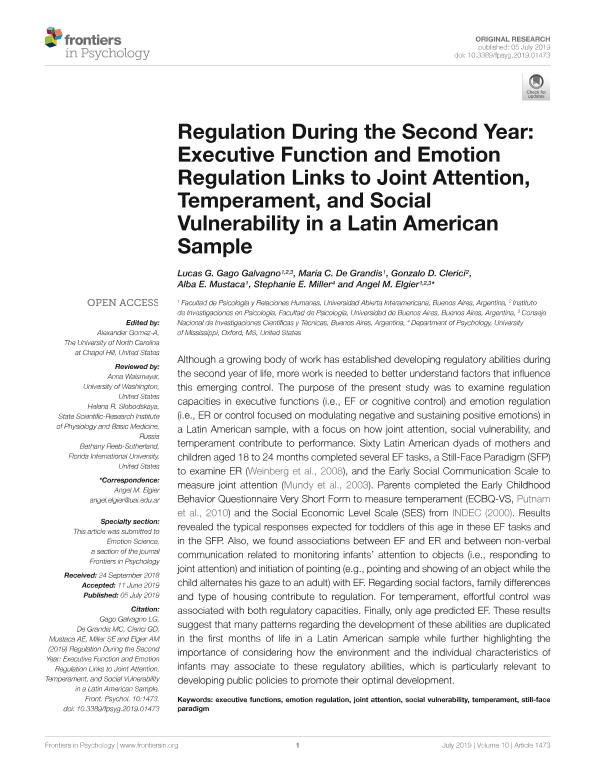Artículo
Regulation during the second year: Executive function and emotion regulation links to joint attention, temperament, and social vulnerability in a Latin American sample
Gago Galvagno, Lucas Gustavo ; de Grandis, María Carolina
; de Grandis, María Carolina ; Clerici, Gonzalo Daniel; Mustaca, Alba E.; Miller, Stephanie Elisabeth; Elgier, Angel Manuel
; Clerici, Gonzalo Daniel; Mustaca, Alba E.; Miller, Stephanie Elisabeth; Elgier, Angel Manuel
 ; de Grandis, María Carolina
; de Grandis, María Carolina ; Clerici, Gonzalo Daniel; Mustaca, Alba E.; Miller, Stephanie Elisabeth; Elgier, Angel Manuel
; Clerici, Gonzalo Daniel; Mustaca, Alba E.; Miller, Stephanie Elisabeth; Elgier, Angel Manuel
Fecha de publicación:
05/07/2019
Editorial:
Frontiers Media S.A.
Revista:
Frontiers in Psychology
ISSN:
1664-1078
Idioma:
Inglés
Tipo de recurso:
Artículo publicado
Clasificación temática:
Resumen
Although a growing body of work has established developing regulatory abilities during the second year of life, more work is needed to better understand factors that influence this emerging control. The purpose of the present study was to examine regulation capacities in executive functions (i.e., EF or cognitive control) and emotion regulation (i.e., ER or control focused on modulating negative and sustaining positive emotions) in a Latin American sample, with a focus on how joint attention, social vulnerability, and temperament contribute to performance. Sixty Latin American dyads of mothers and children aged 18 to 24 months completed several EF tasks, a Still-Face Paradigm (SFP) to examine ER (Weinberg et al., 2008), and the Early Social Communication Scale to measure joint attention (Mundy et al., 2003). Parents completed the Early Childhood Behavior Questionnaire Very Short Form to measure temperament (ECBQ-VS, Putnam et al., 2010) and the Social Economic Level Scale (SES) from INDEC (2000). Results revealed the typical responses expected for toddlers of this age in these EF tasks and in the SFP. Also, we found associations between EF and ER and between non-verbal communication related to monitoring infants' attention to objects (i.e., responding to joint attention) and initiation of pointing (e.g., pointing and showing of an object while the child alternates his gaze to an adult) with EF. Regarding social factors, family differences and type of housing contribute to regulation. For temperament, effortful control was associated with both regulatory capacities. Finally, only age predicted EF. These results suggest that many patterns regarding the development of these abilities are duplicated in the first months of life in a Latin American sample while further highlighting the importance of considering how the environment and the individual characteristics of infants may associate to these regulatory abilities, which is particularly relevant to developing public policies to promote their optimal development.
Archivos asociados
Licencia
Identificadores
Colecciones
Articulos(SEDE CENTRAL)
Articulos de SEDE CENTRAL
Articulos de SEDE CENTRAL
Citación
Gago Galvagno, Lucas Gustavo; de Grandis, María Carolina; Clerici, Gonzalo Daniel; Mustaca, Alba E.; Miller, Stephanie Elisabeth; et al.; Regulation during the second year: Executive function and emotion regulation links to joint attention, temperament, and social vulnerability in a Latin American sample; Frontiers Media S.A.; Frontiers in Psychology; 10; 1473; 5-7-2019; 1-13
Compartir
Altmétricas



